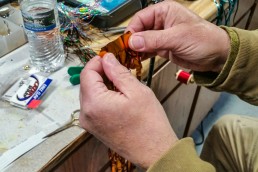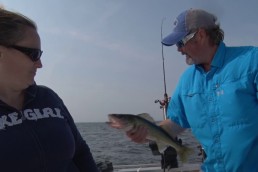Tying your own Lake Michigan Trolling Flies
SHARE THIS POST
A trolling fly behind a dodger has been a reliable, fish-catching combination since I started fishing the “Big Pond” in the mid 70s. Back then, a high-quality trolling fly—complete with hook harness—cost about $2.00. I remember buying a fly tying vice, synthetic bucktail and woven tinsel tubing from Bass Pro and Cabela’s, and tying my own copies. I used plastic cocktail straws for the bodies and tied the trimmed fake bucktail on with sewing thread, securing it with clear nail polish. Beads were added for color and the flies were armed with a single treble hook. The flies ran 4 to 6 inches in length, and cost me about 30 cents to produce. I have ones that are over 30 years old, and still catching fish. Making your own flies, today, will save you about 75% the cost of buying ready made.
Trolling flies now come in different sizes and colors, made of materials I could not have imagined back when I started tying! New UV reflective, glow and holographic body materials give today’s fly tiers a dizzying array of color and flash options. Bullet heads eliminate the need for plastic-tube bodies, and the new beads also reflect UV light or glow in the dark. With all the new and user-friendly materials on the market, making a fly as good as the ones marketed for anywhere between $3.00 and $6.00 has never been easier. Modern tiers also have the Youtube videos to show you step-by-step how to tie.
Imitate or Innovate?
Using the materials of your choice, you can copy the fly that’s a proven killer. My cousin Jim has a green, silver and black fly that seems to catch at least one fish every time out. After looking around for an entire summer and finding nothing even close, I took some cell pictures and sent them to my cousin Ken, who ties flies. We now have a half-dozen clones. Have a certain color combination that just slays the early coho? You can probably tie a half-dozen copies for the price of one original. You can also tie the same colors, in a larger or smaller size fly. You save money and have the satisfaction of catching fish on a fly you made yourself. And, you don’t have to worry about the last one at the tackle store being gone.
Innovating and making up new patterns is also fun. I tied one with a red-and-white bucktail and a gold-tinsel body. I added red and pearl beads, and called it the “Polish fire truck”. I caught my first Skamania rainbow and several large browns on it, behind a silver flasher. I’ve never seen a commercial version of it for sale. Your ability to combine colors of shiny Mylar and flashy body material and beads is limited only by your imagination.
Getting started
You’ll need: fly tying vice, bobbin (holds the thread), thread (several colors), scissors, head cement or clear nail polish and clear tape. Materials like plastic tubes, bullet heads, Mylar plastic body materials and beads are available online and at fly and bait shops.
“Peanut” type flies are the smallest and most simple to tie. Strands of plastic Mylar are tied onto a size-2 treble hook. Start by securing the hook in a vice and marking a few wraps of thread on the shank of the hook. Tie off, and add a little head cement. Then, begin attaching small bundles of body material. Wrap with thread. Take your time to add layers evenly until the hook has tinsel all the way around it—extending out about ½ to ¾ inch past the hooks. Apply head cement and allow to dry, then trim.
Are you enjoying this post?
You can be among the first to get the latest info on where to go, what to use and how to use it!
Mid-size flies
Run these 4 to 6-inch flies during or after the initial spring coho run. We also like to run these way back, shallow, for rainbows. Secure a heavy-duty paper clip in your fly vice, with one end bent straight out, to slide the plastic tubing for the body over. Put a little head cement on the tube and wrap with a light layer of thread to form a base for the body material to hold. Begin layering on your body materials with the primary (main) color first. Add in your other colors, layering them, and keeping the body material as even as possible. Add wraps of thread and a drop or two of cement as you go. Apply cement when finished and allow to dry before trimming.
Flies for the big Chinooks
Yes, you can tie the big boys on plastic tubes. Use the above method, only with longer lengths of body material. Bullet heads are also popular for these bigger-bodied, thicker flies. These should run 6 to 7 inches and use lots of body material. Banded Mylar body material is used in conjunction with the plastic bullet heads and applied using tape to hold the band on the material to the groove on the bullet head before it’s secured with thread. Line up the banded material, tape it together at the banding, and wrap into place. Remember, you are trying to imitate a larger baitfish. Secure with thread, tie and cement in. Allow to dry and trim.
Beads and hooks
Beads come in various sizes, colors and shapes. My best colors were orange, chartreuse, pearl, lime green and glow in the dark. I also tried glass beads, instead of plastic, as I had a theory the glass beads might rattle against each other. I suggest trying colors that will compliment the colors used in the body material. Hooks (singles, trebles, or any combination) should always be good quality. I used nickle-plated trebles for the added flash, but some guys like the red or plain bronzed hooks. Inspect your hooks after catching and replace dulled or bent hooks.
We always used high-quality, 30-pound-test line for leader material. Higher-test line is stiffer and helps impart more of the flasher’s action to the fly. I suggest tying your flies with a 24-inch leader. This will allow enough “slack” to adjust for several sizes of dodger. Run leader lengths using the old standard of 1.5 times to twice the length of the flasher. For a slower presentation, add more length. If in doubt, check by setting the fly and dodger in the water and seeing how it actually runs. If you are not getting the erratic action of a fleeing baitfish, shorten the leader.
There is really no “downside” to tying your own trolling flies. Materials are relatively inexpensive and user-friendly. With a little practice, you will be turning out flies that catch fish. The satisfaction and money you save is just a bonus!
MWO
SHARE THIS POST
Did you enjoy this post?
You can be among the first to get the latest info on where to go, what to use and how to use it!
Ron Stresing
Ron Stresing has fished since age 4 and hunted since age 12, with a lifelong passion for both. He tries to convey the lessons learned over a lifetime of hunting and fishing in Wisconsin. He also writes a column on shotguns for On Wisconsin Outdoors.



